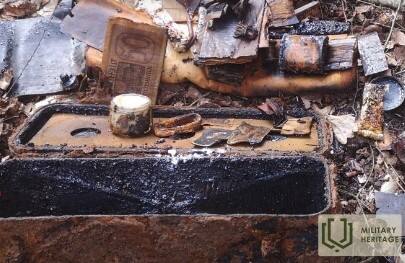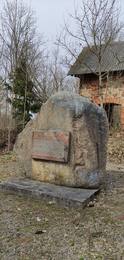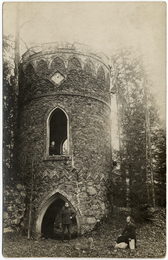Leģionāra Andreja Apsīša mantojums Remtes mežā
2.pasaules kara laika liecības Kurzemes mežos tiek atrastas ik pa laikam, jo kara relikviju un vēstures senlietu tīkotāji Kurzemes mežus un laukus ar metāldetektoriem apmeklē itin bieži. 2021.gada sākumā Saldus novada Remtes pusē mežā apraktā munīcijas kastē tika atrasti dažādi dokumenti, kas apliecināja piederību Latviešu leģiona 19. divīzijai, bet arī karavīra personīgās mantas. Tās zemē bija nogulējušas 76 gadus.
2021.gada sākumā Saldus novada Remtes pusē mežā apraktā munīcijas kastē tika atrasti dažādi dokumenti, kas apliecināja piederību Latviešu leģiona 19. divīzijai, bet arī karavīra Andreja Apsīša personīgās mantas. Tās zemē bija nogulējušas 76 gadus.
Visticamāk, kaste Remtes mežā ierakta 1945. gada maija sākumā. Tai laikā šai pusē notika pēdējās kaujas Kurzemē un atradās arī Latviešu leģiona 19. divīzijas štābs. Līdzās dokumentiem kastē atradās arī daudz personīgu mantu, kas raksturo arī pašu personu, tā, piemēram, dienasgrāmatas pirmajā lapā ierakstīts Aleksandra Čaka dzejolis "Miglā asaro logs", ielikta arī nauda – gan reihsmarkas, gan červonci, fotofilmiņas, formastērpa uzšuves, šūšanas piederumi.
Munīcijas kastē bija ievietoti arī higiēnas priekšmeti – zobu birste un dozīte, kurā atrodas zobu tīrīšanas līdzeklis, kas savu smaržu bija saglabājis.
Kastē atrastais dzīves gājuma apraksts liek domāt, ka tā piederējusi Andrejam Apsītim. Viņa tēvs Hermanis Apsītis no 1934. līdz 1940. gadam bijis Latvijas tieslietu ministrs, cietis no represijām un nogalināts 1942. gadā. Savukārt par dēlu Andreju pašlaik ir skopas ziņas.
"Ir zināms, ka viņš ir nodzīvojis līdz 1996. gadam un miris ir Rīgā, bet šis pārējais posms no kara beigām līdz viņa nāves dienai vēl būtu pētāms. Būtu lieliski, ja varētu atrast arī viņa radiniekus," atzīst vēsturnieks Jānis Tomaševskis.
Tāpat atklāts paliek jautājums, kāpēc Andrejs Apsītis nav šo savu ierakto munīcijas kasti līdz šim pats atracis.
CIP materiāli liecina – aģents “Tilbury” ir bijušais Latviešu leģiona virsnieks Andrejs Apsītis (1919–1996), kurš pēc 2. pasaules kara bija arī Valsts drošības komitejas (VDK) aģents ar segvārdu “Cīrulis”. Respektīvi, Apsītis bija dubultaģents, kura loma CIP un VDK spiegošanas spēlē joprojām nav īsti skaidra.
https://www.lsm.lv/raksts/zinas/latvija/kurzemes-mezos-atrod-2-pasaules-kara-laika-liecibas.a400911/
https://www.delfi.lv/news/national/politics/noslepumainais-beglis-baltijas-jura-kurzeme-atrastas-kastes-ipasnieks-izradas-dubultagents-tilbury.d?id=53147779
Saistītās laikalīnijas
Saistītās tēmas
Saistītie objekti
Piemineklis Sarkanās Armijas 8. igauņu strēlnieku korpusa karavīriem
Piemineklis Sarkanās Armijas 8. igauņu strēlnieku korpusa karavīriem atradās pie Kaulaču pusmuižas saimniecības ēkas drupām apmēram 100 metrus uz dienvidrietumiem no ceļa. Taču dabā vairs neeksistē.
1945. gada 17. martā sākās pēdējais Sarkanās armijas uzbrukuma mēģinājums Kurzemē. Igauņu 8. strēlnieku korpusa 7. igauņu strēlnieku divīzijas uzdevums bija sasniegt Rīgas – Liepājas dzelzceļa līniju uz rietumiem no Blīdenes stacijas un nodrošināt 3. gvardes mehanizētā korpusa uzbrukumu Gaiķu virzienā. Līdz 17. marta vakaram 354. strēlnieku pulks pa mežu sasniedza dzelzceļu uz dienvidiem no Kaulaču pusmuižas un turpināja uzbrukumus ziemeļrietumu virzienā, sasniedzot Pikuļu mājas. Kaulaču pusmuižā un tālāk uz ziemeļaustrumiem atradās vācu izveidotās Burg-Stellung pozīcijas, kuras aizsargāja 329. kājnieku divīzijas atsevišķas vienības. Visu 18. marta dienu turpinājās nesekmīgi 354. strēlnieku pulka uzbrukumi.
18. marta vakarā 354. strēlnieku pulku nomainīja 27. strēlnieku pulks. Uzbrukumam plānoja izmantot arī 3. gvardes mehanizētā korpusa 7. gvardes mehanizētās brigādes priekšējo vienību – 1. motorizēto bataljonu ar vienu tanku rotu. Līdz 19. marta vakaram koncentriska uzbrukuma rezultātā padomju spēki ieņēma Kaulauču pusmuižu, sagrābjot vācu izbūvētās aizsardzības līnijas posmu, kas atradās dominējošā augstienē.
Līdz 1945. gada marta beigām turpinājās 8. igauņu strēlnieku korpusa un 3. mehanizētā korpusa uzbrukumi Vikstrautes un Remtes virzienos, bet bez panākumiem.
Kauju laikā Kaulaču pusmuiža atradās dažādu līmeņu štābi un šajā vietā 1975. gada maijā atklāja piemiņas akmeni.
Remtes muižas apbūve un parks
Remtes muižas pils (vācu: Remten) ir muižas kungu māja atrodas Remtē. Remtes muižas apbūve un parks ir valsts nozīmes pieminekļi. Muižas kungu mājā atrodas Remtes pamatskola. Remtes muižas pils celta 1800. gadā Berlīnes klasicisma stilā pēc toreizējā muižas īpašnieka grāfa Karla Medema pasūtījuma.
2.Pasaules kara beigu posmā Remtes muižā un tās apkārtnē bija izvietota Vācu armiju grupas "Kurland" Latviešu leģiona 19.divīzija.
26 ha lielo muižas parku veido bijušais muižas centrs ar alejām, ainaviskiem koku stādījumiem un savu dīķu un kanālu sistēmu. Ejot parka takām, redzēsiet Medību torni, Lācēnu māju, “Mīlestības ozolu” uc. Parkā nesen izveidota arī Remtes Sajūtu taka, kurā var trenēt un pārbaudīt dažādas maņas, staigājot pa dažāda veida segumiem un konstrukcijām.








